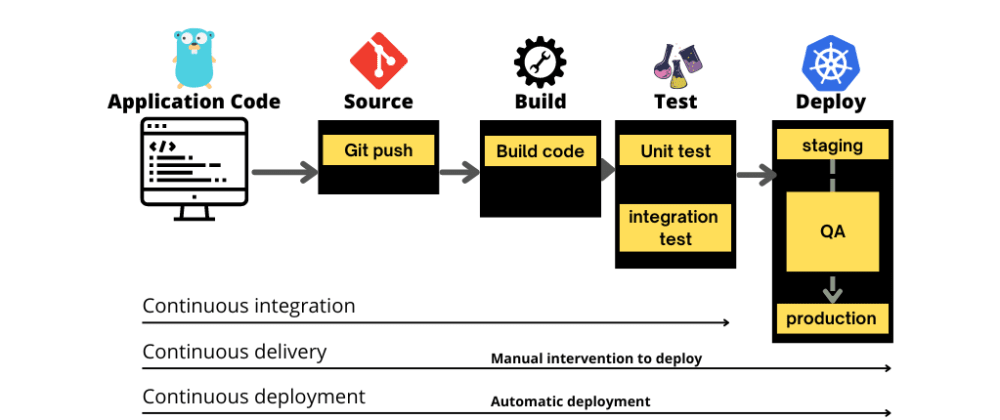Streamlining Software Development with CI/CD Pipelines
 Priyansu Shekhar
Priyansu Shekhar
CI / CD in modern software development
In today's fast-paced world, where software is constantly evolving and new features are in high demand, it has become imperative for development teams to adopt efficient processes. One such process is Continuous Integration and Continuous Deployment (CI/CD). CI/CD is a set of practices that help streamline the software development workflow, enabling teams to deliver high-quality software at a faster pace.
How it works? Process and life cycle
The CI/CD process involves the integration and deployment of code changes in an automated and continuous manner. It starts with developers writing code and pushing it to a version control system, such as Git. From there, a series of automated steps are triggered, which include building the software, running tests, and deploying the changes to various environments. The goal is to catch any issues or bugs early on, ensuring a stable and consistent product.
The life cycle of a CI/CD pipeline typically consists of the following stages:
Code Commit: Developers commit their changes to a version control system.
Build: The CI server pulls the latest code and builds the software.
Automated Testing: The built software undergoes automated tests to ensure its functionality and stability.
Unit Testing: Tests individual components of the software.
Integration Testing: Tests the interaction between modules or services.
Performance Testing: Checks the software's ability to handle varying loads.
Deployment: The tested and validated software is deployed to different environments, such as staging or production.
Monitoring: Continuous monitoring ensures the performance and stability of the deployed software.
Feedback Loop: Feedback from users and stakeholders is collected and used to improve the software.
Components of a CI / CD pipeline
A CI/CD pipeline consists of various components that work together to automate the software development process. These components include:
Source Control: The version control system that stores and manages the codebase, allowing developers to collaborate and track changes effectively.
Build System: The system responsible for compiling the code, resolving dependencies, and creating an executable artifact.
Testing Framework: A suite of tools and techniques used to verify the correctness, reliability, and performance of the software.
Deployment Tools: Tools that facilitate the automated deployment of the software to different environments.
Monitoring and Logging: Systems that monitor the deployed software, collect metrics, and provide valuable insights for troubleshooting and performance optimization.
Feedback Mechanism: A mechanism that collects feedback from users or stakeholders, enabling developers to understand users' needs and pain points.
Best practices
To ensure the effectiveness of CI/CD pipelines, it is essential to follow best practices that maximize efficiency and maintain the quality of the software. Some recommended practices include:
Automate Everything: Automate as many tasks as possible, from building and testing to deployment and monitoring.
Version Control: Use a reliable version control system to manage code changes effectively and facilitate collaboration between team members.
Small Incremental Changes: Break down work into smaller, manageable chunks to minimize risk and maintain a high level of stability throughout the development process.
Code Reviews: Encourage peer code reviews to catch potential issues, improve code quality, and promote knowledge sharing within the team.
Continuous Testing: Implement a comprehensive suite of automated tests to validate the software's functionality, performance, and reliability at every stage of the pipeline.
Release Management: Plan and coordinate releases with proper versioning, change logs, and rollback strategies to ensure smooth deployments.
Continuous Monitoring: Continuously monitor the deployed software for any issues, collect performance metrics, and proactively address potential problems.
Continuous Feedback Loop: Actively seek feedback from users and stakeholders to understand their needs and continuously improve the software.
Tools and their applications
There are several popular tools available that can be utilized to implement CI/CD pipelines effectively. These tools offer various features and integrations to facilitate different stages of the software development process. Some examples include:
Jenkins: A widely used automation server that supports continuous integration and delivery workflows.
GitLab CI/CD: Integrated with GitLab, it provides a complete CI/CD solution, allowing seamless integration and deployment.
Travis CI: A cloud-based CI platform that offers support for multiple programming languages and easy integration with GitHub.
CircleCI: An easy-to-use CI/CD platform that enables automating the build, test, and deploy process.
Amazon Web Services (AWS) CodePipeline: A fully managed continuous delivery service that integrates with various AWS services for building, testing, and deploying applications.
The choice of tools depends on the specific requirements of the project, team preferences, and the integration capabilities needed.
Conclusion
The adoption of CI/CD pipelines has revolutionized the software development process, enabling teams to streamline their workflows and deliver high-quality software faster than ever before. By automating various stages of development, such as building, testing, and deployment, teams can reduce errors, increase productivity, and ensure a robust and reliable final product. Embracing best practices and utilizing appropriate tools will further enhance the effectiveness of CI/CD pipelines, empowering development teams to meet the demands of the modern software industry.
Subscribe to my newsletter
Read articles from Priyansu Shekhar directly inside your inbox. Subscribe to the newsletter, and don't miss out.
Written by


